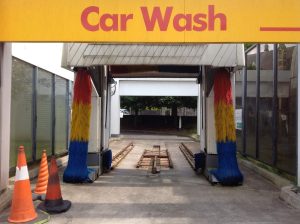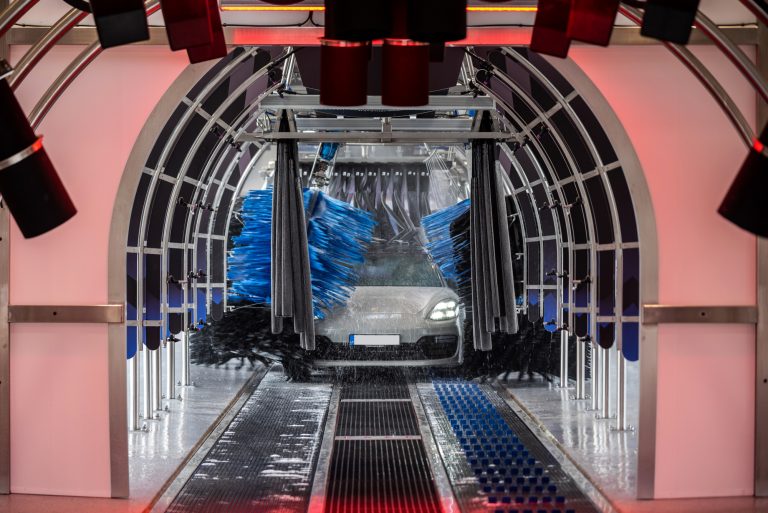Tunnel or in-bay car washes + conversion tips
The advantages of express tunnel car washes over in-bay, and tips on how to convert
Tunnel car washes – already a mainstay in the U.S. – are finally catching on in Europe, too. As the title of this article would suggest, tunnel washes have a number of significant advantages over their in-bay counterparts. Before we go any further, however, let’s define our terms.
In-bay vs. Express tunnel car washes
With an in-bay car wash, you simply drive into the bay and wait for the automated machinery to go through a pre-programmed wash cycle. Once the washing is done, the exit door opens and you leave the bay, making room for the next car in line.

In-bay car washes are typically found in service station complexes (image source pixabay.com)
With express tunnel car washes, instead of staying in one place, your car is pulled along a tunnel on a conveyor belt. Each stop inside the tunnel corresponds to a different moment of the wash cycle. The key difference is that washing is mobile and spatially distributed, rather than stationary and taking place in one spot. In addition, with express tunnel car washes, payment is made without stepping out of the car. The entire wash cycle takes, from payment to exit, is around 96 seconds. This compares to 7-8 minutes with an in-bay wash.

With tunnel car washes, like this one by Pro Bro, cars are pulled through a tunnel with different wash stages
The advantages of express tunnel car washes
There is a reason why express tunnel car washes are already well established in America, and are gaining popularity in Europe as well. They have a number of advantages over in-bay car washes for both users and owners or operators. Here are two of the biggest advantages there have.
Volume
Tunnel car washes have a much greater throughput, allowing multiple cars to be washed at the same time. As the conveyor belt pulls one car to the next station, its place is automatically taken by the one behind it. The whole process takes less than 2 minutes, start to finish. By contrast, in-bay washes take as long as 5-8 minutes to complete the same wash. And this doen not include the time taken to manually enter the code for your car wash, and to enter and exit the bay.
These shorter cycles mean that a much higher volume of cars can be processed each hour. The average in-bay wash can process no more than 12 cars per hour, with 6-8 being the average. By comparison, a modern Pro Bro tunnel wash fits 7 cars inside the tunnel at any one time, and can handle up to 180+ cars per hour. In fact, one of our MAXI units just broke a new record, washing 270 cars in a single hour.
For owners and franchisees, this huge difference in volume means much higher revenue.
User experience
Users also enjoy a number of advantages with express tunnel car washes.
The first clear benefit here is less waiting and faster washes. Express tunnel car washes offer 2-4 times faster speed of service, with washes completed in under 2 minutes.
With in-bay car washes, many drivers simply pass by the service station or convenience store that operates it if they see a long queue. That’s because they understand the queue could mean a 15 or 20 minute wait.
With tunnel washes, on the other hand, there’s either no queue, as the cars are already in the tunnel, or a short, fast-moving one.
Additionally, express tunnel car washes feature more advanced technology. This ensures a higher level of cleanliness and low-labor operation. Plus, they often have a visually striking design that consistently attracts a greater number of users.
Tips on converting your in-bay to a tunnel car wash
Converting your in-bay system into a tunnel wash is probably much easier and less expensive than you think.
In many cases, the existing facilities are largely sufficient for the conversion in their current state. This is primarily because in-bay washes often have plenty of underutilised space that can be optimised in a new system.
The same can be said for the equipment, as well. Some of it will have to be replaced, as tunnel car washes rely on more advanced technology – but not all of it. For instance, things like compressors and pump stations can often be integrated without any changes. That being said, the exact scope of necessary replacements will be determined by engineers on the ground.
A smarter type of car wash
As you can see, express tunnel car washes are the future.
And converting your in-bay wash into a tunnel system can be a low-investment upgrade that can give a massive boost to your car wash earnings.


